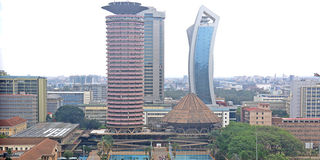
Kenyatta International Convention Centre, in Nairobi. The clash of the ways of the African village with the city is most evident in the use of public spaces, and public utilities in the capital.
The explosion last week at a gas storage and refilling facility in Nairobi’s Embakasi suburb, which killed at least six people and injured over 300, has been blamed on corruption, and shambolic urban governance which allowed such a dangerous installation to be located in a densely populated area. Reports allege that dozens of complaints had been made, and a court had shut the place down, to no avail.
Enter Morris Odhiambo, who lives a short distance from the accident site. Odhiambo is Vice-Chairman of something known as the Diplomacy Scholars Association of Kenya (DIPSAK) and Coordinator, Missing Voices Coalition (MVC) in Kenya.
In an article entitled “PanAfricanists must seek a radical cure for the open wound that is the state in Africa” on the Africanist website, This Is Africa, he uses the Embakasi disaster as an example of wider failures around Africa.
He writes, “Just about two weeks ago, our counterpart in West Africa, Nigeria, suffered an almost similar explosion in Bodija area in the City of Ibadan caused by ‘illegally’ stored explosives”. He then takes an interesting line, writing that, “In many parts of Africa, and Kenya in particular, planning for cities has been thrown out of the window.
The urbanisation that is often celebrated is nothing but villagisation of urban spaces. There is a lot of suffering in these urban villages that are also called informal settlements.”
This idea that part of the problem so many towns and cities in Africa are such a mess is because we have brought our village mentality to them, keeps coming up now and then. Critics argue that it is racist, perpetrating the trope that the “natives are primitive people unsuited to managing a modern creature like a city”.
While anyone battling through Mogadishu, Kampala, Lagos, and Nairobi outside the leafy suburbs, to name a few, might despair, there are also cities like Kigali, Porto-Novo in Benin, Rabat in Morocco, Cape Town, Windhoek in Namibia, and others, that are as orderly and as neat as a city anywhere else in the world can get.
Odhiambo’s argument, therefore, is interesting as a counterpoint. The debatable point he makes is the suggestion that urban filth, poverty, and lack of accountability, are products of “villagisation”. Yes and no. To this day, most traditional African villages are not filthy.
There is no garbage strewn around, partly because villagers produce mostly organic waste, which is thrown in gardens as manure or buried in their backyards. The menace that has come to them in recent years is plastic, which the cities took to them.
Villages are still governed by codes, that are generally observed. You don’t defecate on a village path. If you do, you are considered mad, and you risk the curse of elders being placed upon your head or household.
The clash of the ways of the African village with the city, however, is most evident in the use of public spaces, and public utilities. Take something as basic as going to a mosque or church. Traditional African village life never had the separation between where we lived, and where we prayed.
You didn’t walk five kilometres away to go and worship your god. You prayed and sought protection against evil forces at the shrine that was at the back of your house. Very efficient.
The commons were functional. You didn’t use the open field to bask in the sun or for picnics. You grazed your cattle there or spread hides and dried your crop on the edge. The best waters weren’t fenced off for people to swim in.
They were for fishing, a spot for livestock to drink from, and for villagers to draw for domestic use. I witnessed this village tradition of the use of the commons play out in dramatic contradiction in Bangui, the capital of the Central African Republic. Some fields in the city had been left to grow so the people could graze their cattle there, and at some point in the year, they were mowed for folks to play football. While the cattle feed is growing, the residents will find dusty grounds nearby to play on.
The village drunkard didn’t need to buy his booze all the time. Even without a penny in his pocket or a brewery in his kitchen, he would always be welcome to sit around a pot from which more organised villagers were drinking and have his fill.
To this day, fellows still rock up in village bars, and other drinkers will pour out for them a glass of the blinding local gin they are gulping. It is easy to see where the ways of the village might be problematic in modern cities.
The national stadium cannot be a part-time grazing field, when you have club football matches, international athletic championships, and the Africa Cup of Nations going on.
Still, if we behaved like villagers, our cities would be cleaner and not be strewn with rubbish. There would be fewer dangerous things left on the road. They also would be friendlier. If nothing else, no one would drink alone.
- Mr Onyango-Obbo is a journalist, writer, and curator of the “Wall of Great Africans”. Twitter@cobbo3







